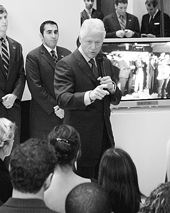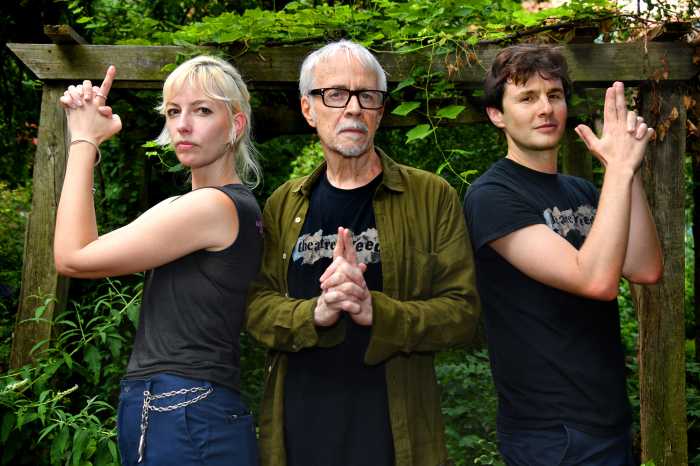By Hannah Seligson
The next big movement in mobilizing young voters will soon be happening in our backyard. Generation Engage, a nonpartisan organization aimed at raising the political profile of young adults, particularly those who are not in college, has picked New York as one of three states to launch its pilot program. At a fundraising event last Tuesday night, at the Polo Ralph Lauren store on Madison Ave., former President Bill Clinton addressed a young, energetic crowd at the first official Get Engaged Simulcast, which included their two other locations in Richmond, Va., and Raleigh, N.C. The event was held to help secure funds to expand the organization’s New York operation.
“More than any other time, you have the opportunity to do public good,” Clinton told the young group. “When you walk away from voting, you can’t say what people used to say or might have said: ‘Oh well, my vote doesn’t make a difference.’ Clearly, your vote does.… People are dying to be asked to do something.
“Whether you are Republican or Democrat, liberal or conservative, think government should or should not be more involved, you can’t go on thinking, ‘This is the way things are. There is nothing I can do.’ It’s not true,” Clinton said. “You cannot for the rest of your life look in the mirror and say, ‘I regret this, this and this. I wish America were this, this and this.’ You know they’re giving you a vehicle to do it. That’s why I’m honored to be here to support the cause.”
Generation Engage has garnered attention and support from political heavyweights, such as Bill Clinton, that budding organizations only dream of. However, Generation Engage is defined by more than early support from big-name politicians because it has proven that it not your typical youth-voter movement. Motivated by what its founders brothers Devin and Adrian Talbott and Justin Rockefeller saw as campaigns characterized by token celebrity appearances, partisan issues and targeting of only college students, Generation Engage decided to carve out a different approach for mobilizing young voters 18 to 24 years old who are not in college. These are the forgotten half — the 49 percent — of college-age individuals without college experience. Another key part to the new organization’s mission is being nonpartisan.
“Politics isn’t a monologue,” Adrian Talbott said. “The minute you remove the other part of the conversation, it is a nonparticipatory process.” Generation Engage has been bringing candidates from both sides, such as the Virginia gubernatorial candidates, to discuss and debate issues.
Generation Engage feels young college-age people not in college are merely disenfranchised, not apathetic.
“In New York City, we want to focus on young people who believe in the organization, understand and care about the broader New York City area and have the skill set necessary to combine their commitment to Generation Engage’s mission with their commitment to their community,” Devin Talbott said.
“We at the top of Generation Engage don’t pretend to know what strategies for civic engagement work best for each community, which is precisely why we invest in the right young people at the local level,” Rockefeller said. It is these local youth leaders that will try to point those at the top in the direction of where to set up Generation Engage HotSpots — a term Generation Engage uses to refer to recreation centers, places of worship, pool halls, community centers, athletic facilities, bars and any other hangout or social institution where young people socialize. HotSpots serve as the central gathering points for Generation Engage activities and will ultimately be places where candidates are invited to speak. Aiming big, Rockefeller could see Union Square turning into a Generation Engage HotSpot. “I think the creativity of our local standout hires will show that the possibilities are almost limitless.”
As young people who came of age in the age of dot-com era, the Generation Engagers plan to use technology to get young people interested in the political process and to catalyze local political events and discussions. Using simulcast technology, candidates would debate and discuss issues that could be broadcast to thousands of young people over all five boroughs.
While Generation Engage has not been active in New York during this election cycle, they are committed to being active and visible year-round. Ali Samadi, a Generation Engage board member who lives in New York City, “We felt like New York City really needed something every election cycle, not just highly concentrated efforts around election time.”
Generation Engage has been successful at gaining attention from national and international political figures, such as Senator Chuck Hagel, a Nebraska Republican; Bill Clinton; Cherie Blair and Coretta Scott King. However, a cornerstone of their approach is engaging youth and politicians at the local level. As evidence of this, four New York City councilmembers, Gifford Miller, Helen Foster, David Yassky and Eric Gioia, were in attendance at the recent simulcast.
“Generation engage is one of the most exciting voter-engagement efforts in the country today,” Yassky said. “This movement is exactly the kind of voter mobilization that America needs in the face of major decisions about homeland security, Social Security and Medicare.”
With an office in Harlem and plans to open one in the Bronx, Generation Engage is well on its way to becoming a visible force in New York City politics. “It is our goal to be fully involved in the 2006 election cycle,” Adrian Talbott said. Generation Engage sees New York City as having huge potential because of its large concentration of young, energetic and motivated youth that flock here. However, even with all the opportunities that come with this bastion of young voters, there will inevitably be challenges. As Rockefeller sees it, “Young New Yorkers don’t always know the most fruitful way to channel their energy. Generation Engage will have to work to amplify their voices and channel this energy, and hopefully create some lifelong, responsible voters in the process.”
This, however, is no small task, and Generation Engage certainly has its work cut out for it.
According to the Center for Information and Civic Research, which studies youth voting patterns, 45 percent of voters aged 18 to 24 voted in New York in the 2004 election, slightly higher than the national average of 42 percent. Comparatively, however, New York ranks in the bottom half of states in terms of youth turnout. More troubling, however, and an indication that Generation Engage has picked a state much in need of a grassroots mobilizing effort, is that voter participation in New York among 18-to-24 year-olds has dropped 12 percent since 1972. Yassky, for one, has noticed a palpable disengagement from politics in New York City. “New York City has some of the most active citizens in America,” he said. “But there are many who have given up, who are disenfranchised and who would benefit greatly from a program like Generation Engage. A nonpartisan, agendaless program such as this can more easily reach potential voters and make them care more about their government.”
With 15-to-24-year-olds making up 13.9 percent of New York City’s population — or well over 1 million New Yorkers — there clearly is a wealth of potential young voters who are not active in the political process. According to the Common Cause Education Fund, a nonpartisan voter-education research organization that focuses on youth turnout, more than half of these youth are people of color.
Even with the challenges and growing pains of starting a new organization in such a transient and diverse city, Generation Engage is optimistic about the potential it has to hook young New Yorkers on the political process. “The creativity, hard work and drive that makes New York City so great has a lot of potential to incite political debate and engagement,” said Devin Talbott. “New Yorkers are active, interesting and outgoing. They work hard and they play hard. That is an energy level that we hope to be able to tap into.”
thevillager.com





































